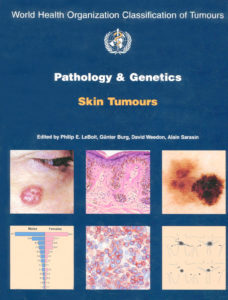World Health Organization Classification of Tumours. Pathology and Genetics of Skin Tumours
Zusammenfassung
Dieses Buch über Hauttumoren ist Bestandteil einer Serie von Büchern der World Health Organization zur Klassifikation von Tumoren. In sieben Kapiteln („Keratinocytic tumours“, „Melanocytic tumours“, „Appendageal tumours“, „Haematolymphoid tumours“, „Soft tissue tumours“, „Neural tumours“ und „Inherited tumour syndromes“) werden die meisten relevanten Hauttumoren in knapper, übersichtlicher Form dargestellt. Zunächst wird jeweils die Epidemiologie diskutiert.
Es folgen Verteilungsmuster, klinisches Erscheinungsbild, histopathologische und immunhistochemische Charakteristika, etwaige Varianten und Differenzialdiagnosen, Genetik, Histogenese und schließlich Angaben zur Prognose. Neben Neoplasien finden auch tumorähnliche Veränderungen Berücksichtigung, zum Beispiel Keloide und hypertrophe Narben im Kapitel über „Fibrous, fibrohistiocytic and histiocytic tumours“ (Weyers W, Mentzel T, Kasper RC et al.) oder das Lymphangioma circumscriptum im Kapitel über „Lymphatic tumours“ (Requena L, Weyers W, Diaz-Cascajo C). Nicht berücksichtigt sind einige Neoplasien, die in anderen Bänden der WHO-Reihe dargestellt werden, wie zum Beispiel Liposarkome und andere Weichteiltumore. Das Buch gibt den aktuellen Wissensstand über kutane Neoplasien wider und beinhaltet über 2600 Verweise auf die wichtigsten Arbeiten der neueren Literatur.
Kommentare zum Buch
“Pathology and Genetics of Skin Tumors“ is the latest volume in the new WHO series on histological and genetic typing of human tumours. This authorative, concise reference book provides an international standard for dermatologists, pathologists, and oncologists and will serve as an indispensable guide for use in the design of studies monitoring the response to therapy and clinical outcome. … Academics will need to have a copy if only to refer to it when preparing lectures and contrasting its statements with their own viewpoints.
Mark A. Hurt, Dermatopathology: Practical and Conceptual 2007; 13: 1.
This is a very good book that is a largely complete and up-to date compendium of skin tumors that will be a well used (and useful) addition to dermatologists, pathologists, and dermatopathologists in academic and private practice.
Yadira Hurley, Dermatopathology: Practical and Conceptual 2007; 13: 1.
This is a comprehensive, well-illustrated, and timely text put forward by a constellation of experts. It reflects current thinking as regards the classification of these tumors and is an attempt to standardize terminology. This terminology will undoubtedly evolve as we reach a better understanding of the true biology of these tumors. The appeal of this book is wide. I would strongly recommend it to general pathologists, clinicians, and dermatopathologists at all levels.
Valda N. Kaye, Dermatopathology: Practical and Conceptual 2007; 13: 1.
